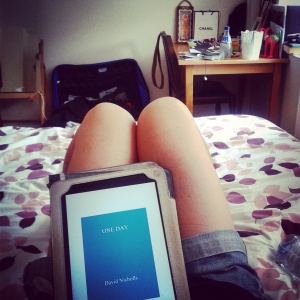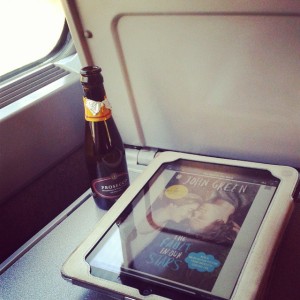I signed up to a website that’s going to drive me to bankruptcy in £1 increments. It’s called BookBub.com, a website that seeks out cheap or FREE books on Amazon, Kindle, Apple etc. I’m going straight to slow readers book hell.

Many years ago, a very close friend whose opinion I hold in very high regard, once told me that she didn’t waste her time with “faffy romance novels”, wrinkling her nose up just enough to (unintentionally) make me feel ashamed of my youthful reading habits – Not that I ever got quite as far as the Mills and Boon brigade, mind you, but I had, up until this point eagerly consumed enough Sushi for Beginners to be suffering rice bloat.
Ever since then, I have always felt a little bit ashamed of reading love stories. So it was, with full knowledge that this was a love story, that I parted with my £1 because stuff it, I wanted to.
What a perfectly named book, hinting at the promise and the disappointment of a sighed “One day…” but also the format of the story telling – each chapter covering the story of Dexter and Emma for just one day, 15th July, each year for 20 years.
The book perfectly captures the hope and overestimated potential of a new grad, and the sustained small crompromises, disappointments and often unnoticed tragedies that happen over the course of a lifetime.
Elements of Emma’s character hit so close to home I found myself cringing in shame at past experiences, remembering grandiose statements and gross generalisations I’ve made about politics and the state of the world, reliving arguements or conversations I’ve had with my own friends, past boyfriends or the Pet Expert.
In parts I unfairly judged it too predictable, thinking that relying on obvious stereotypes to colour Dexter’s life was laziness on the author’s behalf. But on reflection, these behaviours can be related to by anyone who’s had a few too many drinks and survived, hungover and ashamed to tell (or maybe be told) the tale.
I became so ensconsed in the lives of the main characters, so filled with hope for them, that I didn’t see the crescendo coming, and it was so abrupt and disconcerting that I spent the last chapters in tears.
Having wept so ridiculously, I felt depressed for much of the rest of the afternoon, realising waaaay too late that it’s the kind of book you should finish when your flatmates are home, so you’ve someone to cheer you up after. The book should come with a mental health warning, something along the lines of “Do not read this text whilst driving or listening to early Radiohead albums”.
Luckily I was saved from wallowing for too long by a late afternoon invite to dinner at a friend’s place… Thank frock for that!







